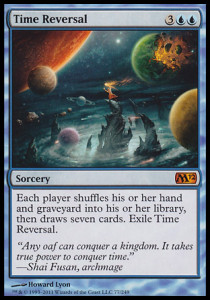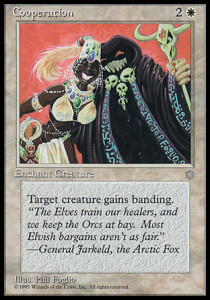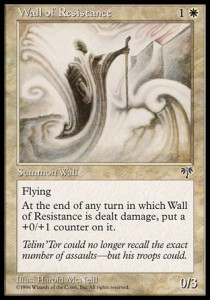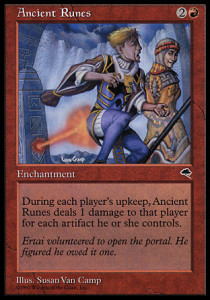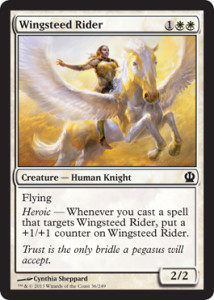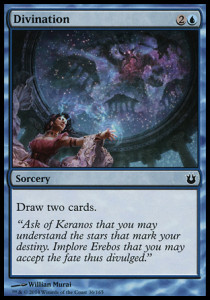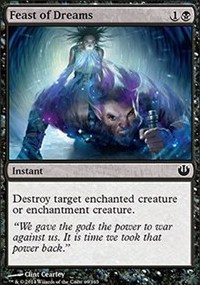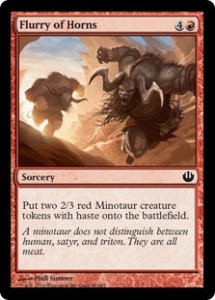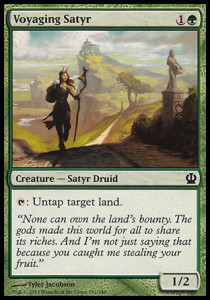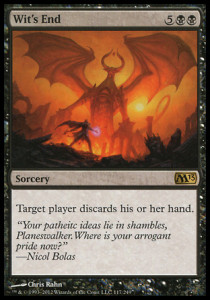After a break, a rough start, and less practice than usual, I finally feel like I’ve gotten a handle on the format. I’ve 3-0ed team drafts, won 8-4s, and came in top 16 in my last PTQ. I’m no master, but I both feel more confident and that I’ve some good ideas about the format. I’d like to share them.
The speed of the format has shifted. Heroic decks, while viable, are nowhere near as dominant, fast, or consistent as they used to be. Games tend to go longer and end when players have few to no cards in hand. Accordingly, cards like Divination, Griffin Dreamfinder, Read the Bones have gotten much better (when before, taking a turn off to durdle was a dangerous, and sometimes fatal play).
Synergy matters more. Constellation, even on seemingly minor effects like Harvestguard Alseids or Grim Guardian, can swing games with a trigger (ever combined Alseids with God-Favored General or Forgeborn Oreads with Twinflame?). Minotaur lords are better than ever with the surprisingly strong Flurry of Horns. Junk graveyard-based decks got a big boost from cards like Font of Return and the slower speed of the format.
Evasion is better. Flying creatures like Prescient Chimera and Blood-Toll Harpy were a bit too slow and too easily blanked by Nessian Asp or Wingsteed Rider in triple Theros and Born of the Gods. Now, there’s a lot less reach, far fewer Nessian Asps, and more opportunity for air support to dominate games.
Stabilizing when behind is harder. With less bestow and ordeals, you’ll have fewer opportunities to bounce the one creature your opponent goes all-in on (’cause your opponent won’t be doing that as often). With fewer Nessian Asps and Leafcrown Dryads, you’ll have a much harder time finding excellent blockers, particularly for flying creatures. The format may allow slower decks, but that doesn’t mean you can afford to not commit to the board. Defensive creatures like Rotted Hulk and Coastline Chimera are better than ever and necessary to keep pace with what pressure your opponent applies.
The old rules still apply. You still need to have a plan for T1 Favored Hoplite, T2 Ordeal of Heliod, even though the situation’s less likely. Sure, the format allows slower decks, but heroic aggro still exists and BR aggro is better than ever. Don’t show up to a knife fight with nothing but durdle!
Journey into Nyx changed quite a bit about pick orders and color commitments. I continue trying to commit to one color in my first pack (hopefully ending the pack with at least six good-or-better cards in a single color, with some strong off-color cards to support the inevitable second color). Here’s what’s going through my mind as I crack my first pack.
White
White, particularly aggressive white, seems the weakest color in Journey into Nyx. Its only heroic common in Journey into Nyx is Lagonna-Band Trailblazer (which is very good at blocking and not dying—blocking being the opposite of what heroic aggro wants to do). White has fine aggressive creatures in Oreskos Swiftclaw and Eagle of the Watch, but nothing spicy.
Ajani’s Presence is exceptionally powerful and warrants a high pick… but one risks drafting a bunch of tricks in Journey and not getting enough heroic creatures to enable in Born or Theros (though those Wingsteed Riders and Akroan Skyguards will be going later than usual). It’s high risk, but the potential reward may be worth it.
Slower white is better than ever, thanks to cards like Akroan Mastiff (which is a slow, but very strong removal spell). It pairs very well with black, thanks to cards like Scholar of Athreos, Underworld Coinsmith, and Odunos River Trawler.
White is the color I’ll least often start a draft in. If I suspect that more than one other person is in heroic white, I’ll jump into another color. I will, however, pick up late Ajani’s Presences or Akroan Mastiffs and flirt with white in Born of the Gods.
Blue
Blue is the best color in all of Theros. While it was never the best color in any particular pack (I argue that those colors are green in Theros and red in Born of the Gods), it’s always second best and is finally king of the hill. It has the best and most plentiful common removal spells (bounce is still excellent), the best card advantage/smoothing, and some of the best evasive creatures.
There are so many blue commons you can and should first pick! Sigiled Starfish is nuts. It finds you the cards you need when you need them and blocks very well (far too often I see players not blocking with their Starfish, not realizing that their opponent would need to take the whole turn off and have a combat trick to “punish” them (and by punish, I mean trade one-for-one)).
Hubris is usually better than Voyage’s End, since undoing all of bestow is an even bigger tempo swing. Cloaked Siren is a strictly better Snapping Drake (a Limited star) and tends to go far later than it should. The humble Pin to the Earth is actually busted, given that it’s Swords to Plowshares/Silence the Believers in disguise. War-Wing Siren is worse than it looks, given that Wingsteed Rider is worse than ever, though still a fine card. Font of Fortunes is a good thing to pick up as the slower format rewards card advantage and superior card quality.
In short, I want to be blue in draft. Blue should be overdrafted, given that it’s strong in every pack, but I don’t think it’s being drafted heavily enough yet.
Black
Black is the second strongest color in Journey into Nyx, thanks to its excellent and varied removal (particularly Feast of Dreams and quality control creatures like Pharika’s Chosen and Grim Guardian. If you can snag multiple copies of Grim Guardian and build around them (say, a WB or GB constellation/attrition/recursion deck), your deck will be very difficult to beat in a long game.
When drafting black in Journey, it’s more important to receive a good signal than send one. If black is open in Journey into Nyx, it’s likely that it’ll also be open in Theros (when you can hopefully pick up late copies of Gray Merchant of Asphodel and Keepsake Gorgon). If you don’t receive a black signal in pack one, you may well push the drafters to your left out of black, but they only send you Born of the Gods, a pack where black is among the weakest colors.
Black is a great, if not the best color to start in, though it’s a bit thinner than blue. If it’s not open, it’s okay to abandon black or relegate to a support color.
Red
Red is become the best aggressive option (particularly when paired with black), edging white out of its heroic dominance. Bladetusk Boar and Magma Spray are fine first picks (Magma Spray being the less exciting of the two), Flurry of Horns is a shockingly strong finisher, and Rouse the Mob will kill your opponents out of nowhere.
Satyr Hoplite, like Akroan Crusader, is a high-risk card that may end games quickly or be completely useless. Sigiled Skink is the two-drop red needed in Theros: it fills out the curve nicely and smoothes your draw (which red needs more than any other color). Starfall is underwhelming as it’s almost always significantly weaker than Lash of the Whip (a serviceable but hardly stellar removal spell).
I recommend drafting red the opposite of how I draft black: red is best in Born of the Gods and weakest in Theros. Accordingly, you want to send a very strong signal that red isn’t open in pack one in the hopes that you’ll get lots of red in pack two. By the end of Born of the Gods, you want to have most of your deck finished (or the red half, at least).
I will rarely start a draft in red, but I’ll often end the pack with several good red cards. Whether and how much I commit to the color depends entirely on how the pack of Born of the Gods goes.
Green
Green was and remains an always solid choice. Golden Hind is basically Voyaging Satyr, and Voyaging Satyr is insane. You should be first-picking Golden Hind, and if you’re in green, and you aren’t, you’d better have just taken a higher rarity card. Oakheart Dryads is strong on its own and fabulous in multiples. Ravenous Leucrocota is aggressive, defensive, and a late-game threat all in one. You should be picking all of these cards higher.
My favorite green common, however, is Font of Fertility (though it’s not better than the three aforementioned commons). My ideal green draft starts with Golden Hind and continues with some copies of Font of Fertility. Snagging that much ramp and fixing early on means that one can splash or just play three colors and not worry about mana or the feasibility of hitting enough mana for finishers like Kraken of the Straits or Vulpine Goliath.
If I’m starting in green, all I want to do is ramp. Failing that, I want to set up for a good midrange/constellation deck. Failing that, I want to be in another color.
That’s about all of my thoughts (patheitc as they might be—isn’t it nice how rare typos like that are in Magic?). I know that my strategies aren’t universal and that they’ve fallen prey to decks that I’ve disparaged, like Boros beats, UR tempo, and WG heroic. I’d like to hear your thoughts—when you open your first pack, what goes through your head? What colors do you want to be in and what cards will be your strongest signals?
As always, thanks for reading.
—Zachary Barash
Zachary Barash has been playing Magic on and off since 1994. He loves Limited and drafts every available format (including several that aren’t entirely meant to be drafted). He’s a proud Cube owner and performer, improvising entire musicals every week with his team, Petting Zoo. Zach has an obsession with Indian food that borders on being unhealthy.

